2
Then let us try the graph of y=x2.
By drawing the tangents of each point, we can calculate the gradients. However, as the graph is not always accurately drawn, there must be some error between the results. In order to avoid this, I am going to use another method to calculate the gradients: increment method.
Increment method works like this: you need 4 numbers: x1, x2, y1, y2. If you want to get the gradient of the co-ordination (1, 1), namely (x1, y1) in the graph y= x2, then look for a very close number as x2 to x1, usually 1.01, then use the equation of the line to work out y2, which can be got by square x2 and gives you the value 1.0201. And then put the numbers in the formula below:
(y2-y1)/(x2-x1)
Which gives you the value of the gradient you want, 2.01
The advantage of this method is to get a very accurate answer instead of a rough answer with spending an amount of time drawing the sketch of the graph.
The results are shown below:
First, I found that the gradients increase as the co-ordinates increase. I not only found this by looking at the table of the results, but also by looking at the graph: the lines get steeper and steeper. It also shows that the larger x is, the larger the difference between x2 and g.
Let us see the relationship between X and g.
g1=2=2x1
g2=4=2x2
g3=6=2x3
g4=8=2x4
Obviously, the formula for y=x2 is g=2x. According to this, I predict that the formula for y=x3 will be g=2x as well.
First I will draw the graph to make it clear that how the line will be like.
Let me obtain the results.
3
My formula g=2x does not work for this equation. However, I found another formula for this equation. See below:
g1=3=3x12
g2=12=3x22
g3=27=3x32
g4=28=3x42
It means that the gradient function for y=x3 is g=3x2, as you see this formula does work. It proves again that the increment method is much more accurate than tangent method. And also from now on the line in the graph is tend to be much steeper and steeper so that it makes it hard and not accurate to draw the tangent, so I am going to use increment method from now on.
Things are not solved yet; I have to look at the formula for these three times to find any possible relationship. In y=x, g=1=x0; in y=x2, g=2x; in y=x3, g=3x2; as we can see, in the three gradient formulas, the number before x and the indices are both increasing as the indices of the equation get higher, and the difference between the number before x and the index is 1 (the index number is smaller than the number before x). So I predict that the gradient formula for y=x4 is: g=4x3.
Let’s try it out.
The co-ordinates:
The gradients in y=x4:
g1=4=4×1=4x13
g2=32=4×2×2×2=4x23
g3=108=4×3×3×3=4x33
g4=256=4×4×4×4=4x43
So my prediction works this time! Look at the table of the previous steps below:
I got the gradient function. It can be written in this way:
When y=xn, g=nxn-1
4
Just to be certain, I will try y=x5:
5×14=3
5×24=80
5×34=405
5×44=1280
My formula does work! And notice that because of the high number, increment method is now not so perfect.
The equations I have tried so far all have positive numbers as their indices, but I think this formula should work on equations whose indices are negative e.g. y=x-1 and y=x-3, and whose indices are fractions e.g. y=x1/5y=x-1/2namely negative numbers and fractions as well. In order to make sure, let’s look at all these equations.
In order to make the process simple and clear, I am just going to put the value of x, the gradients by using increment method and the gradients by using my formula.
First, I will look at the equations with negative numbers:
y=x-1:
As you can see the formula does work. However I will still look at y=x-3 to make sure.
y=x-3
5
It does works again! Now let’s look at the equations with fractions as their indices.
y=x1/5:
This proves again that my formula can work on complex equations, too. I am going to try another example to make it certain. Notice that this time the index number of the equation is a negative fraction.
y=x-1/2
I can strongly say that the gradient function can also work on fractions and negative numbers.
However, this gradient function is only a basic one; we can develop it to make it suit all kind of cases e.g. y=2x3, y=4x2+3x. How to work them out? I will take y=2x3 as an easy example: first, work out y=x3 by using g=nxn-1; second, multiply all the results by 2. That is, to split up the equations.
If you want to work out a more complex equation such as y=4x2+3x, just divide the equation into two piece, y=4x2 and y=3x, then do it one by one as shown below:
y=4x2:
y=3x:
After you have done this, simply combine the two together.
6
Using tangent method in my graph I can check that my results are correct.
This method can work on any similar type of equations.
In this piece of the coursework I have discovered that we can get the gradient of any line at any point by using the formula g=nxn-1, and it work on positives, negatives, fractions and complex equations.
7
Chords
An approximation to the gradient at any point can be found by drawing a chord. A chord joins together two points on a curve. The closer together these two points are, the closer one gets to the actual gradient of the graph at the point in question.
Therefore in the above diagram, AB and AC are chords. The gradient at A is closer to the gradient of AC than AB, since the chord AC is shorter. Every time one makes the chord shorter, the gradient of the chord gets closer and closer to the gradient of the curve at A. Eventually, when the chord becomes so short that it is a tangent, the gradient of the graph will equal the gradient of this tangent. The derivative.
8
Algebra
We can use algebra to find out what the gradient of this tangent will be.
A is any point, (x, y). To find the gradient at A, we need to find the gradient of the tangent at A. Let B be a point which is just a little further along the graph. The gradient of the chord AB is approximately the gradient of A. If the horizontal distance between A and B is called dx ('delta' x) and the vertical distance between A and B is called dy, the coordinates of B are (x + dx, y + dy).
From the coordinate geometry section, we know that the gradient of a straight line joining two points is:
y2 - y1, where the two points are (x1, y1) and (x2, y2)
x2 - x1
In this case, the two points are (x, y) and (x + dx, y + dy). So substituting these values into the formula, the gradient of the chord is:
y + dy - y = dy (pronounced 'delta y by delta x')
x + dx - x dx
This is the gradient of the chord. The gradient of the curve is the gradient of the chord when the chord has no length- ie when it is a tangent. This will happen when dx = 0 .
The gradient of the curve is therefore:
lim (dy)
dx --> 0 (dx)
This basically means that the gradient is dy/dx as dx approaches or 'tends to' (-->) zero.
We can rewrite the coordinates of (x, y) as (x, f(x)) and the coordinates of (x + dx, y + dy) as (x + dx, f(x + dx)), since y is a function of x (y = f(x)).
9
So the gradient of the curve is:
lim (y + dy - y)
dx --> 0 (x + dx - x)
since y = f(x) and y + dy = f(x + dx):
Gradient is:
lim f(x + dx) - f(x)
dx --> 0 dx
This is denoted by dy/dx ('dee y by dee x'). dy/dx is known as the derivative of y with respect to x.
So, in summary,
dy = lim f(x + dx) - f(x)
dx dx --> 0 dx
Example:
Find the formula for the gradient of the graph y = x² .
dy = lim (x + dx)² - x²
dx dx --> 0 dx
= lim x² + 2xdx + (dx)² - x²
dx --> 0 dx
= lim 2xdx + (dx)²
dx --> 0 dx
The dx on the denominator cancels with those on the numerator.
Therefore dy/dx =
lim 2x + dx
dx --> 0
When dx becomes zero, dy/dx = 2x.
Therefore the gradient of y = x² is 2x.
For example, at the point (2, 4), the gradient is 2x = 4 .
10
Conclusion
During this coursework I have learnt a great deal about straight lines, curves, algebra and in particular gradients. I have been able to set out my results in a table and I noticed a general pattern. From this pattern I was able to produce a general formula for the gradient of a curve i.e.
if y=xn, G=nxn-1
This result enabled me to find the gradient of more complicated curves, such as the coursework curve i.e.
if y=4x3+2x-5
G=49(3x2)+2-0
=12x2+2
I can now find the gradient at any point on the coursework curve just by substituting the x value at that point into the formula for the gradient i.e.
if at the point P (0, -5), G=2
I have no doubt that the mathematics I have learned will be useful to me at GCSE level and in more advanced work in other subjects in the future.
If I had more time I would like to investigate other curves to see if my result still holds
e.g. y=1/x2, y=1/xn, y=sin x, y=cos x, y=tan x
I predict that the formula would work for the first two groups but I am not sure if it would work for the trigonometry. This could be investigated in a further coursework project.
11







